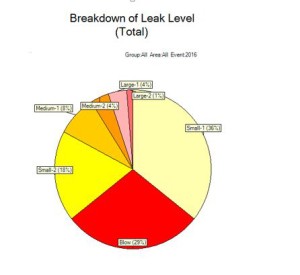IMPROVEMENTS IN THE STEAM SYSTEM STARTS WITH THE STEAM SYSTEM SURVEY
 Due to fluctuation in energy costs, steam production costs have varied significantly in recent years. When these costs were insignificant, economic analysis did not justify repairs of steam leaks from bad gaskets, holes, valves, or leaking steam traps. As steam costs escalated, the economics started to favor the repairs of these same problems. While steam costs vary, a Preventative Maintenance program to survey for leaks and to perform regular steam trap surveys is always a SMART practice for Facility Managers.
Due to fluctuation in energy costs, steam production costs have varied significantly in recent years. When these costs were insignificant, economic analysis did not justify repairs of steam leaks from bad gaskets, holes, valves, or leaking steam traps. As steam costs escalated, the economics started to favor the repairs of these same problems. While steam costs vary, a Preventative Maintenance program to survey for leaks and to perform regular steam trap surveys is always a SMART practice for Facility Managers.
While the cost of steam can be a basis for decision making regarding the repair of leaks, it should not be the only reason. Other factors that need to be taken into consideration are the cost and availability of water, cost of downtime, and production/process efficiency.
A proper steam trap maintenance program is essential to a steam system. Defective steam traps not only waste energy, they contribute to pipe corrosion due to poor water quality and contaminants allowed to pass downstream. Defective steam traps can adversely affect product quality in numerous manufacturing processes and even add to environmental pollution. It is important to inspect steam traps regularly by conducting a steam trap survey.
The frequency of steam trap survey is best determined by the application. As an example, steam systems used just for facility heating are normally inspected annually, while systems that utilize steam as part of a manufacturing process should be inspected more frequently, depending on the importance that steam has on the process. While there are many organizations that routinely provide “preventive maintenance” by replacing trap parts annually, this is not very practical. In fact, it can prove costly and ineffective since traps can fail open or leak in Smart Valves Inc.ween these preventive maintenance appointments, and many traps will work for years before a trap needs to be replaced. It is more cost effective to establish a well-documented routine for the steam trap survey.
As part of any maintenance routine, a good understanding of the system is critical. For this reason, before inspection starts, drawings with all the steam traps and valves in a facility needs to be available. Also, it is important that all traps be tagged and referenced on the drawings. In addition, the steam trap inventory should include information on the trap type, manufacturer, and application. To increase steam trap survey effectiveness, it is recommended that historical record keeping and data collection be employed to receive information about the steam system over time. This is useful not only to account for savings realized but for spotting potential areas of recurrent problems. To make this accounting easier there is multiple steam trap management software programs which can be quite valuable in maintaining accurate records.
Besides record keeping, it is important to consider various methods of inspection. The most common methods are a combination of visual inspection, temperature measurements, and ultrasonic testing. Ultrasonic testing helps to isolate the sound of trap and valve operation to readily identify leaks or component malfunction. It also is the only way to quantify how much actual steam is lost at each steam trap.
In summary, if you have a steam system and you have not performed a steam trap survey in the last 18 months, it is time to schedule a consultation with one of our engineers to assess your situation and to help you establish a routine steam trap survey program. It is a SMART first step to improve your steam system efficiency and lower operating costs.
Let’s discuss your needs

